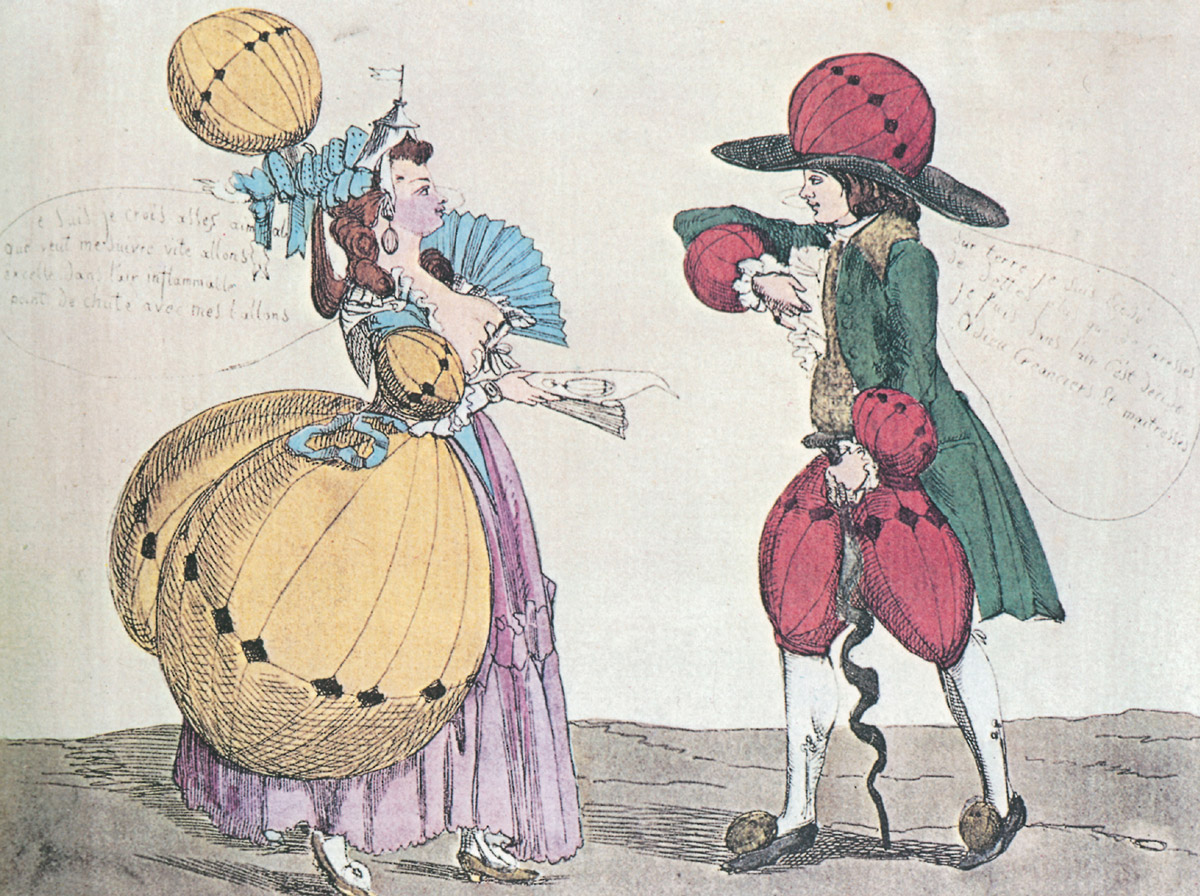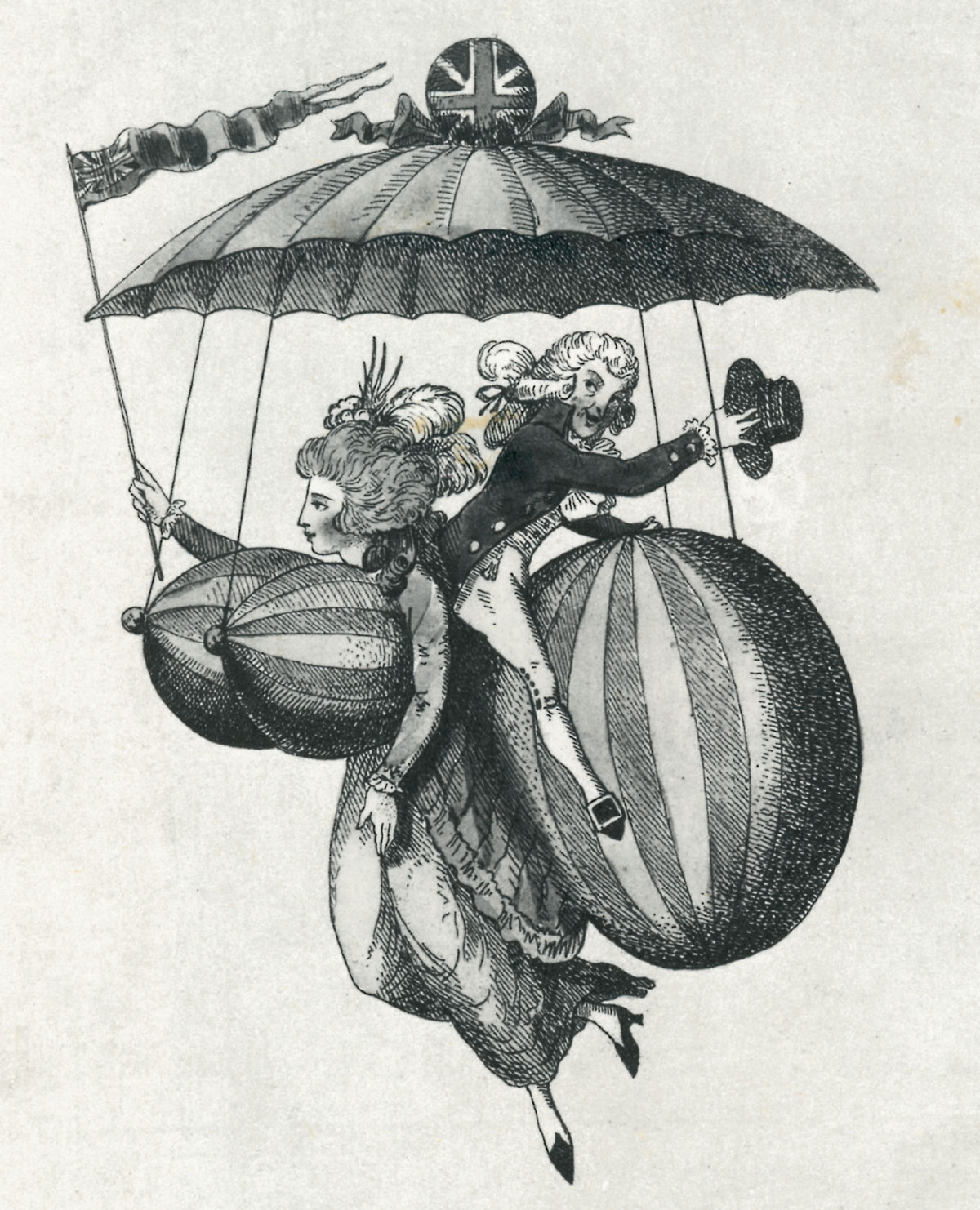Inflationary Models
Balloons in fashion
Sasha Archibald

Shortly after the first successful hot-air balloon launch on 5 June 1783, a French newspaper, the Mércure de France, announced “balloon mania.”[1] The phrasing was not tongue-in-cheek, for the early balloon launches were truly riotous affairs. Attended by up to 60,000 spectators, these outdoor public spectacles or “experiments,” as they were called, were part enthusiastic celebration of Enlightenment science and part mean-spirited curiosity in the abysmal failures of the inventors. Snared by trees, rooftops and cathedral spires, tossed by storms, burned by hydrogen flames, or tangled in the ropes of their own balloons, many early aeronauts plunged to their deaths before the crowd. The spectators themselves posed a formidable danger, mercilessly abusing the balloonists on the frequent occasions that their attempts were thwarted by technical difficulties. If the ascent wasn’t high or fast enough, spectators were known to attack and destroy the offending balloon, thereby sabotaging the aeronaut’s means of earning back his investment, and in one case at least, set fire to their chairs in disgust.
Understandably, ballooning quickly developed a few crowd-pleasing gimmicks—cats and dogs were dropped from great heights with parachutes (another developing technology) tied around their stomachs; popular opera singers performed from the balloon baskets; aeronauts tried to nurture a cult of personality; and on one ill-fated trip, a balloonist attempted a fireworks display. In 1785, balloon entertainment took an innovative turn: tickets were sold to view the Aerostatic Grape-Picker, an inflatable man suspended 15 feet above the French countryside.[2]

The launches were made all the more spectacular by the fashions of the spectators. The political, social, and economic turmoil of the late 1700s accelerated the evolutionary pace of style and precipitated some brief but extreme fashions. The caricatures shown here have inspiration in several sources. The artist has drawn a comparison between hot-air balloons and a women’s fashion trend that either coincided with, or perhaps was inspired by, the first balloons, called robe retroussée dans les poches. In robe retroussée dans les poches, the massive skirts of the ladies’ dresses were pulled up by their ends to reveal an underskirt and tucked into side pocket-slits. The style created voluminous starched puffs around the hips which, as fashion historian Stella Blum points out, “transform[ed] the original silhouette into an entirely different configuration”[3] —a configuration that was distinctly balloon-like. Puffs of fabric at the hips and backside were counterbalanced by styles that increased the projection and ornamentation of the bust, creating a pigeon-like effect. The caricatures also spoof women’s hairstyles of the time, which frequently bore three-dimensional figures perched on immense piles of hair, lace, ribbons, feathers, and filler added for height and structural support. In 1782, for example, Sébastien Mercier expressed his preference for the hairstyles in the Parc Anglais, with their “windmills, woodland grove and streams, sheep, shepherd and shepherdesses, a hunter in the copse.”[4] Hair adornments were used to celebrate military victories and scientific achievement; the first balloon flight by the Montgolfier brothers gave occasion for hats á la Montgolfier, followed by hats á la Blanchard (the inventor of the parachute), au demi-balloon and the bonnet au globe. Printed and embroidered on fans, purses, shoes, and men’s waistcoats (busts of Voltaire and Rousseau were also popular patterns), balloons instantly became a ubiquitous design theme.
The balloon motif, however, was short-lived. These fanciful styles were to be the last gasps of rococo; in a few years, fashion completely gave way to neo-classicism, inspired by idyllic rural scenes and epitomized in Marie Antoinette’s empire-waisted white muslin gowns, natural curls, and flat gold sandals.
Ballooning, however, continued its history of mishaps.
- This story appeared in the 17 February 1784 issue of Mércure de France, reprinted in J. Jobé, The Romance of Ballooning: The Story of the Early Aeronauts (New York: Viking Press, 1971), p. 31.
- Incidentally, the Aerostatic Grape-Picker was followed only a year later by rumor of an inflatable woman who never left the ground—her purpose being something else entirely. Walking in the Gennevilliers countryside, François Thélémy chanced upon this “finely dressed” woman “rocking on her feet.” Thélémy grasped the woman in his arms before he realized that she was made of hollow rubber. Startled, but not displeased, Thélémy took the inflatable woman home, where “no one but the most distinguished residents was honored with a sight of it.” This story appears in a newspaper article from 23 October 1786 reproduced in The Romance of Ballooning, p. 54.
- Stella Blum, ed., Eighteenth-Century French Fashion Plates in Full Color (New York: Dover Publications, 1982), p. vii.
- Madeleine Delpierre, Dress in France in the Eighteenth Century, trans. Caroline Beamish (New Haven: Yale University Press, 1997), p. 118.
Sasha Archibald is an assistant editor at Cabinet.
Spotted an error? Email us at corrections at cabinetmagazine dot org.
If you’ve enjoyed the free articles that we offer on our site, please consider subscribing to our nonprofit magazine. You get twelve online issues and unlimited access to all our archives.